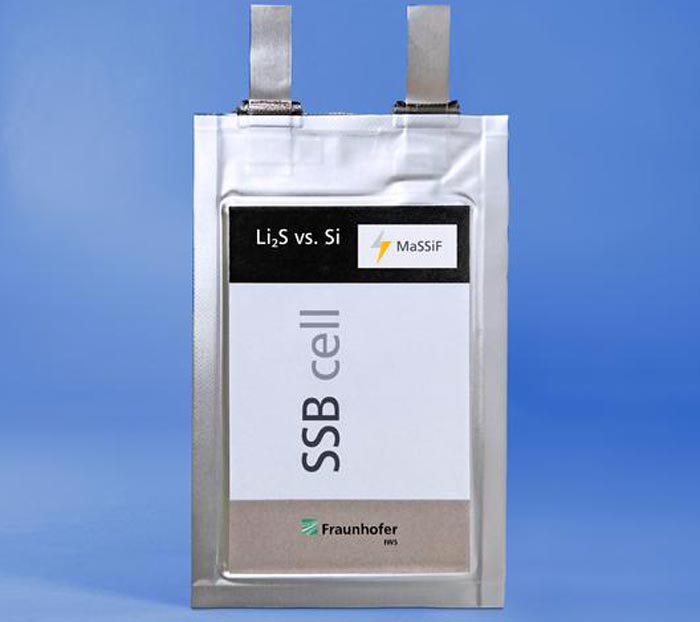Sulfur and Silicon as Building Blocks for Solid State Batteries

Very light and cost-effective: high storage capacities and low material costs should enable the research and development of a new generation of batteries based on sulfur.
© Fraunhofer IWS
BMBF Project “MaSSiF” Explores Innovative Battery Concept.
A new generation of lithium-sulfur batteries is the focus of the research project “MaSSiF – Material Innovations for Solid-State Sulfur-Silicon Batteries”. The project team dedicates itself to the design, construction and evaluation of lightweight and low-cost sulfur-based prototype cells with high storage capacities. Thanks to high storage capacities and low material costs, the sulfur-based concept potentially enables the construction of very lightweight and cost-effective batteries. Applying silicon as the anode material is also expected to significantly improve the cycle life of the battery cells. The German Federal Ministry of Education and Research (BMBF), under the leadership of the Fraunhofer Institute for Material and Beam Technology IWS in Dresden, will provide funding for six partners from science and industry with a total of nearly 2.9 million euros. The project was launched in February 2023.
Solid-state batteries based on sulfide are considered a possible successor technology to today’s lithium-ion batteries and promise greater range and safety for use in electric vehicles thanks to their high energy density and stability. The combination with sulfur as the cathode active material holds particular promise. Free of the critical elements cobalt and nickel used in lithium-ion technology, sulfur achieves very high energy densities in solid-state batteries. However, the anode poses major challenges in the battery’s processing and operation. Current research aims to use metallic lithium as negative electrodes in solid-state batteries. The high reactivity of lithium limits the stability and safety of such cell systems. In the context of the BMBF project “MaSSiF”, the partners are therefore focusing on an anode material that has also proven to be a promising alternative in current scientific research for use in solid-state batteries: silicon. The combination of sulfur (or lithium sulfide), a solid electrolyte and silicon should result in an innovative cell concept that combines low material costs and high energy density.
Achieving Efficiency Advantages in the Network
The “MaSSiF” project involves research institutes and industrial manufacturers of all the necessary key components to investigate the fundamental structure-property relationships and to process and design components and cells. In this way, battery cells with 350 watt-hours per kilogram and a service life of more than 300 cycles are to be produced. In addition to the high specific energy, there should be significant cost advantages compared to today’s Li-ion batteries thanks to low-cost, sustainable raw materials and a short, local supply chain.
- Fraunhofer IWS coordinates the project and contributes know-how on innovative processes for the production of electrodes and prototype cells
- Fraunhofer IFAM develops optimized separators for the lithium-sulfur battery cell based on the researched solid electrolytes
- Scientists at Westfälische Wilhelms-Universität Münster will research tailor-made solid electrolytes and their transport properties for the new battery type
- Wacker Chemie AG supplies silicon and know-how for manufacturing anodes with this material
- AMG Lithium GmbH develops and produces sulfidic solid electrolytes and supplies novel cathode active materials based on lithium sulfide
- Schunk Kohlenstofftechnik GmbH takes on the production of carbon additives or industrially relevant composite materials
Wissenschaftliche Ansprechpartner:
Dr. rer. nat. Holger Althues
Division Manager Chemical Surface and Battery Technology
Fraunhofer Institute for Material and Beam Technology IWS Dresden
Winterbergstraße 28, DE-01277 Dresden
www.iws.fraunhofer.de
Phone +49 351 83391-3476
holger.althues@iws.fraunhofer.de
Originalpublikation:
https://www.iws.fraunhofer.de/en/newsandmedia/press_releases/2023/press-release_…
Media Contact
All latest news from the category: Power and Electrical Engineering
This topic covers issues related to energy generation, conversion, transportation and consumption and how the industry is addressing the challenge of energy efficiency in general.
innovations-report provides in-depth and informative reports and articles on subjects ranging from wind energy, fuel cell technology, solar energy, geothermal energy, petroleum, gas, nuclear engineering, alternative energy and energy efficiency to fusion, hydrogen and superconductor technologies.
Newest articles

Making diamonds at ambient pressure
Scientists develop novel liquid metal alloy system to synthesize diamond under moderate conditions. Did you know that 99% of synthetic diamonds are currently produced using high-pressure and high-temperature (HPHT) methods?[2]…

Eruption of mega-magnetic star lights up nearby galaxy
Thanks to ESA satellites, an international team including UNIGE researchers has detected a giant eruption coming from a magnetar, an extremely magnetic neutron star. While ESA’s satellite INTEGRAL was observing…

Solving the riddle of the sphingolipids in coronary artery disease
Weill Cornell Medicine investigators have uncovered a way to unleash in blood vessels the protective effects of a type of fat-related molecule known as a sphingolipid, suggesting a promising new…





















